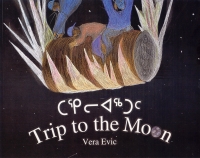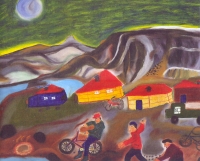| ________________
CM . . . . Volume XX Number 8 . . . . October 25, 2013
Dedicated to the children at the Mianiqsivik Pairivik daycare in Pangnirtung, Nunavut, Trip to the Moon is a fantastical story created for the community by the community. Rather than following the traditional model of a single author, this book is the result of a collaboration led by Mianiqsivik Pairivik between the community of Pangnirtung and Inhabit Community, an imprint of Inhabit Media. A contest was held, and all community members had the opportunity to submit a story. Vera Evic's story of a trip on an oil drum spaceship to the moon was chosen.
This fantastical tale was illustrated by Elisapee Ishulutaq, Andrew, Qappik, Jolly Atagoyuk, Peona Keyuakjuk and Jessica Akpalialuk, young artists from the Pangnirtung-Uqqurmiut Inuit Artist Organization. The collaboration of these artists, rather than resulting in a fractured visual narrative, actually enhances the collectiveness of this tale's creation. Their pictures are created in different media, from dreamy watercolour to rich acrylic and vibrant oil pastels, and offer readers many different views of the community instead of a single dominating view. The excitement of the discovery of this magical oil drum is mirrored in the shift from one artist's work to another. The orality of the story is clear in Evic's prose. With its simplicity of form, Evic's writing draws the reader into the adventure of the story. She does not spend time describing Pangnirtung since her model of storytelling assumes a local audience, but instead allows the illustrators to create a vivid landscape to fill in the details. Evic's focus on the action of the story results in a story that is concise and without literary pretension. She makes readers feel as if she was standing in front of them telling them her tale. One can hear the dramatic tones of her voice through her use of repetition: "As they got farther and farther away from the earth, everything became darker and darker and the stars appeared closer and closer" (p. 10). There is a rhythm and pace to her storytelling. Slower, contemplative passages, like the meeting of the moon people, are followed by fast-paced action. Like an amusement park thrill ride, just when a reader thinks that the action is over, Evic's story surprises with a last burst of excitement which re-energizes her audience. Reading deeper into the text, the discovery of the little people on the moon may be a literary device used to draw a comparison to the tourism industry in the North. Pangnirtung, as the gateway to Auyuittuq National Park, sees many visitors seeking to experience a landscape and way of life that is exotic and foreign, much like the boys learning about the ways of the little moon people. At the end of the day, however, home beckons, and the boys/tourists return to the comforts of the familiar. This story, like those of an oral tradition, draws full circle. While this book reflects a view of the world from Pangnirtung, families and libraries in southern communities would also benefit from learning about life in the North. Similar to Richard Van Camp and George Littlechild's masterful work, What's the Most Beautiful Thing You Know About Horses?, Trip to the Moon can open children's eyes to a different way of life in their own country. At the same time, these readers in southern Canada are able to spot a connection between their imagination and the Pangnirtung children's dreams of a trip to the moon. Working in concert, these two strategies can foster skills of cultural sensitivity and empathy in readers. Recommended. Sabrina Wong is a librarian at the University of Calgary.
To comment
on this title or this review, send mail to cm@umanitoba.ca.
Copyright © the Manitoba Library Association. Reproduction for personal
use is permitted only if this copyright notice is maintained. Any
other reproduction is prohibited without permission.
NEXT REVIEW |
TABLE OF CONTENTS FOR THIS ISSUE
- October 25, 2013.
AUTHORS |
TITLES |
MEDIA REVIEWS |
PROFILES |
BACK ISSUES |
SEARCH |
CMARCHIVE |
HOME |

 This model of community empowerment allows children in Pangnirtung and other northern communities to see themselves and their environments reflected in published materials. The story's setting, Pangnirtung, is central to the tale. Pangnirtung is a town on the coast of Baffin Island which can only be reached by sea or air. The choice of an oil drum as a magical object may seem unusual to a young reader from a southern community, but judging from the lack of surprise expressed in the story and the location of the community, it is a common enough object in Pangnirtung. Children also have the chance to read the story in either English or Inuktitut, a choice which further affirms their place and empowers them as participants in the written world.
This model of community empowerment allows children in Pangnirtung and other northern communities to see themselves and their environments reflected in published materials. The story's setting, Pangnirtung, is central to the tale. Pangnirtung is a town on the coast of Baffin Island which can only be reached by sea or air. The choice of an oil drum as a magical object may seem unusual to a young reader from a southern community, but judging from the lack of surprise expressed in the story and the location of the community, it is a common enough object in Pangnirtung. Children also have the chance to read the story in either English or Inuktitut, a choice which further affirms their place and empowers them as participants in the written world.